-
July 23, 2019 by Total Fire and Safety
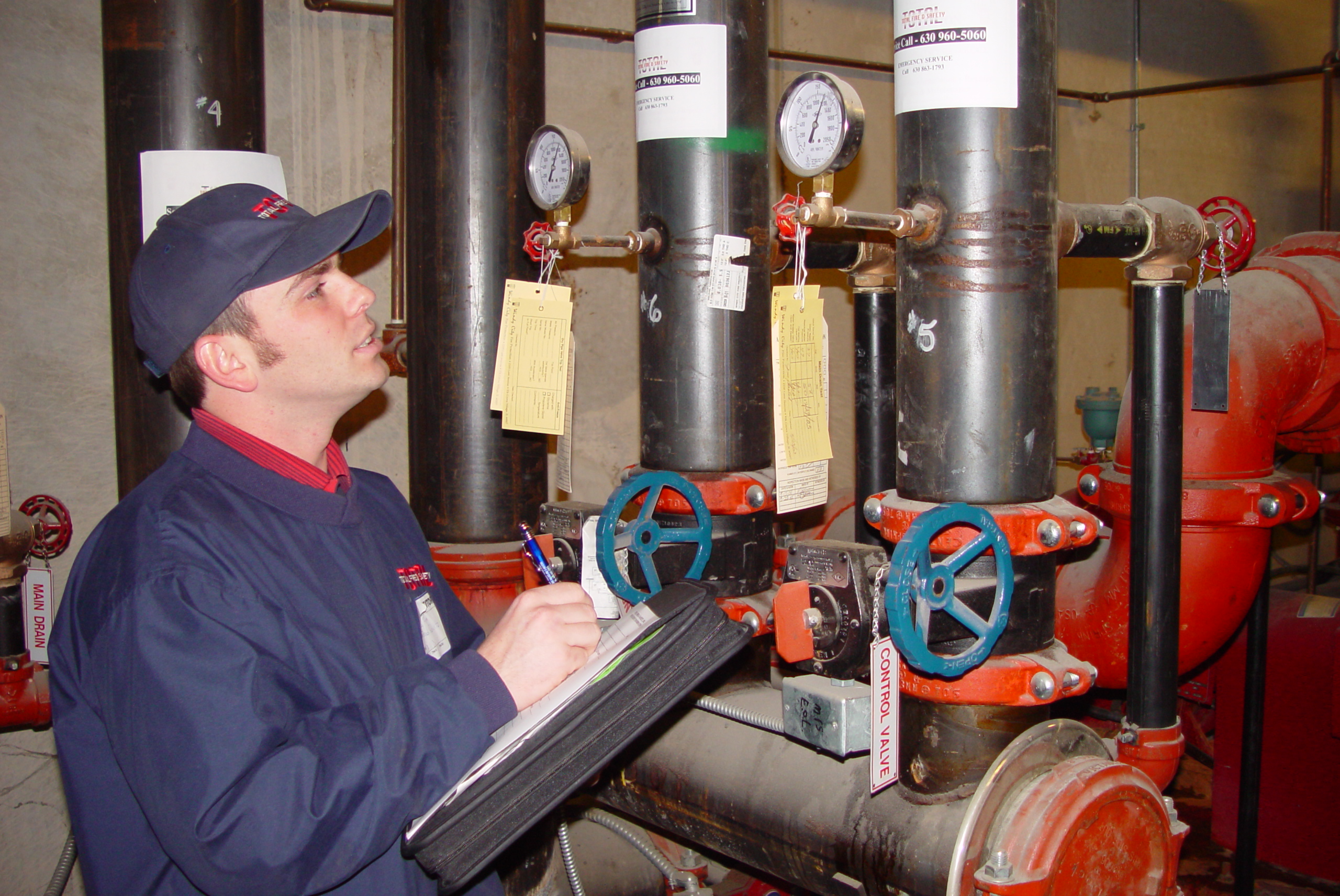
When people think of careers in fire safety in Illinois, they usually think of firefighters. But what about the folks who prevent the fires in the first place? These dedicated professionals work in the area of commercial fire safety. They help commercial buildings and residential dwellings stay up to code with the fire safety equipment, and thus, can save lives indirectly by keeping people safe and prepared for fire emergencies.
Providing fire safety to any business, at any level, starts with teamwork. If one aspect of fire safety fails (sprinkler, extinguisher, or alarm), it can make the difference between life and death. All the fire safety components work within a life safety ecosystem, which includes government code compliance, a skilled workforce, and an investment in safety equipment, installation, and training. As part of a commercial fire safety team such as Total Fire and Safety, you are part of a life-saving mission. We provide customers their first offense in putting out a fire on their premises.
According to the Bureau of Labor Statistics and their Occupational Outlook Handbook, the projected employment change for security and fire alarm system installers is expected to grow 14 percent, which is faster than the average career. They are expecting growth of 10,400 new jobs between 2016-2020. Currently, Illinois, the home state of Total Fire & Safety, is among the states in the nation that employs the most installers in this field. (see chart below).
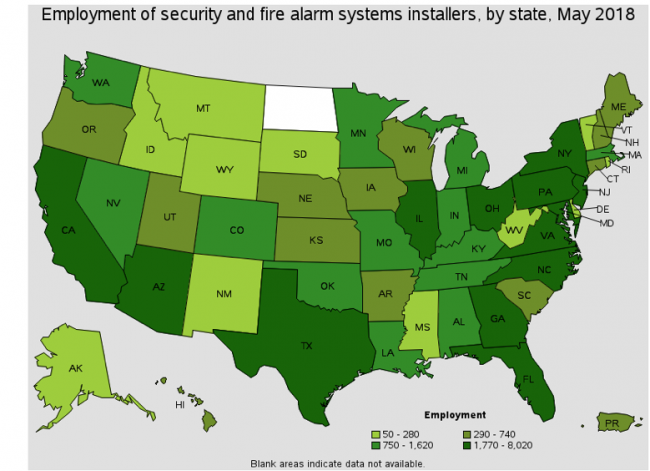 Chart reprinted from Bureau of Labor Statistics, Occupational Employment and Wages, May 2018, 49-2098 Security and Fire Alarm Systems Installers
Many of the careers in fire safety require a high school diploma or equivalent but mainly, on-the-job training. At Total Fire & Safety, we have a vigorous employee training program that prepares our people for many of the jobs that are so needed in the industry, such as customer service, sales representatives, dispatchers, fire alarm service technicians, fire extinguisher technicians, fire sprinkler service technicians, etc. We even have an on-site training facility (pictured below) where we regularly host classes and training modules for TFS employees.
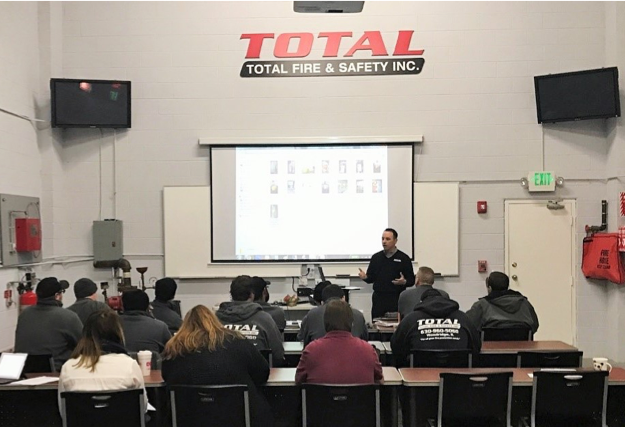
You’ve heard the phrase teamwork makes the dream work, right? At Total Fire and Safety we are always looking for dedicated professionals to join our commercial fire safety team, which has that has provided fire safety for over 30 years. If you are looking for employment or are ready for a career change, join Total Fire and Safety and see how working as a team can save lives.
To learn more about the opportunities available and experience needed at Total Fire and Safety, visit our employment page or search us on Indeed.
Category: Business Safety, Fire Safety, Total Fire and Safety Tags: commercial fire protection, commercial fire safety, employee training, fire and safety equipment, fire safety, fire safety training, Fireextinguishertraining, firesafetytraining, Total Fire and Safety, training | Comments Off on Find Your Career in Illinois Commercial Fire Safety
-
May 20, 2019 by Total Fire and Safety

(Photo credit: Dreamstime ID 95654936 © Wavebreakmedia Ltd | Dreamstime.com)
With the rise in popularity and construction of senior living centers, fire safety continues to be a concern to keep our grandparents, parents, and aging loved ones protected. According to the United States Fire Administration, in 2015, older adults represented 15 percent of the U.S. population and suffered 40 percent of all fire related deaths. They are also 2.7 times greater risk of dying in a fire than the total population. Those 85 and older were 3.8 times more likely to die in a fire than the total population.
The elderly in multi-level dwellings are at higher risk of dying in a fire for several reasons. They may be on medication that impairs them from taking stairs down to safety, or their mobility issues may prevent them from moving quickly enough. They may live alone or have no one to call for assistance. Educating property managers, caretakers, and the elderly on fire safety for senior citizens is one step we can take in protecting this aging generation. Below are some considerations for property managers and their tenants.
1. Test Smoke Alarms
Smoke is a silent killer. Senior citizens with hearing problems who sleep without a hearing aid could be killed in their sleep. Having a working smoke alarm in every room and hallway helps, but they should be effective for the user. Strobe alarms are best, and seniors can install alarms that shake their bed to rouse them in the event of a fire. Most importantly of all, make sure to test smoke alarms every month so they are always in compliance.
2. Sit Your Butt Down…in the proper place!
Smoking is the number one cause of fire deaths in the country. Remind senior citizens never to smoke in bed and especially not near flammable oxygen tanks. Seniors can use deeper or heavier ashtrays to avoid ashes flipping or falling onto the rug and starting a fire. The best way to put butts out is with sand and water.
3. Create a Fire Escape Plan
Seniors may have less than three minutes to escape danger in the event of a fire. They should have a fire escape plan and practice it, knowing all the accessible exits. For seniors suffering from dementia or Alzheimer’s who have escape proof doors, it is important they have a prearranged escort in the event of a fire.
4. Stay in the Kitchen
Seniors should always stay in the kitchen when cooking. Most kitchen fires begin because food is left unattended, so if they must leave the kitchen while cooking they should turn the burner off. Even a short absence from the kitchen can unexpectedly turn into an extended amount of time away. If seniors must leave the kitchen, they should take a cooking utensil or potholder with them to serve a helpful reminder. Also, remind seniors to never cook with loose or dangling sleeves that can easily ignite and burn a senior, or potentially start a major fire.
5. Daily Necessities
Seniors should think about what they use to get around every day, like glasses, a wheelchair, a cane, etc. These items should be placed next to the bed for easy access in case of fire. A phone and a whistle should also be at bedside. The whistle lets people know where you are and enables you to warn others of the fire. Escape is always the priority; call the fire department later. If trapped, use the phone to call for help. Seniors with wheelchairs or walkers should check exit routes ahead of time to be sure they are accessible or plan an alternate route. Inform building managers or neighbors of the plan. If your impairment makes it impossible to escape in the event of a fire, discuss your concern with landlord, or check with the fire department.
6. Don’t Overload Outlets or Extension Cords
Inspect your extension cords regularly for fraying, exposed wire, or loose plugs. Unplug extension cords when not in use. If you need to plug in multiple appliances, use an extension cord approved by the Underwriter’s Laboratories (UL), a nationally recognized testing laboratory.
As their population begins to grow, fire safety for senior citizens cannot be stressed enough. Property managers, caretakers, the elderly, and their families should all be aware of the increased risk to the age group and try to protect them. The professionals at Total Fire and Safety are ready to help ensure your building has fire equipment that is working properly. We provide the life safety features that keep fire safety for your residents, including senior citizens, a main priority. Give us a call today! 630-960-5060
Category: Fire Alarm Monitoring, Fire exits, Fire Extinguishers, Fire Safety, Total Fire and Safety, Uncategorized Tags: fire and safety solutions, Fire Extinguisher, fire safety, fire safety solution, fire safety training, fire training, first aid, lifesafety, Total Fire and Safety, wireless fire alarm monitoring | Comments Off on Fire Safety for Senior Citizens
-
April 24, 2019 by Total Fire and Safety
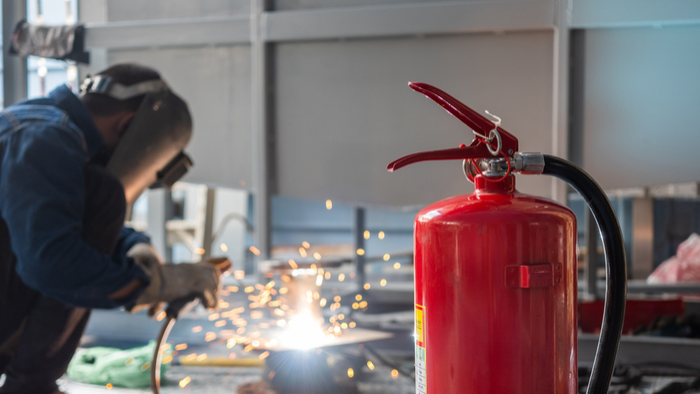
According to the National Fire Protection Agency (NFPA), between 2011 and 2015, there was an estimated 37,910 fires at industrial properties each year. These industrial fires resulted in 16 civilian deaths, 273 civilian injuries, and $1.2 billion in property damage.
Industrial fires are serious, but there are several things you can do at your plant or factory to minimize the possibility of an industrial fire. First, it’s important to know how they usually start.
The five most common causes of industrial fires are…
1. Combustible Dust Fires
A combustible dust is any dust or fine material that has the potential to catch fire and explode when it is mixed in the air. Many times, materials that are normally considered non-flammable can act as a combustible when fine particles are mixed with air in a particular concentration. Combustible dust happens in two waves. A primary explosion causes particles to become airborne, and then the dust cloud can ignite and cause a secondary explosion, much more severe than the first. Combustible dust can bring down entire facilities.
How do I Prevent Combustible Dust Fires?
- Implement a hazardous dust inspection, testing, housekeeping, and control program.
- Regularly inspect for dust residues in open and hidden areas.
- Use proper dust collection systems.
- If ignition sources are present, use cleaning methods that do not generate dust clouds.
- Control smoking, open flames, and sparks (mechanical and friction).
2. Hot Work Fires
Hot work is any activity that involves open flames or generates sparks or heat. This includes welding, heat treating, grinding, thawing pipes, torch cutting, brazing, soldering, etc. Hot work becomes a fire hazard when sparks and molten material travel…often as far as 35 feet, sometimes igniting combustible dust in other areas.
How do I Prevent Hot Work Fires?
- Train personnel on the hazards associated with hot work and make sure they are using proper safety equipment.
- Clear area of flammable materials including dust, gases, and liquids.
- Make sure a safety professional is on site to provide supervision of the work.
- Avoid hot work if possible.
3. Flammable Liquid and Gas Fires
These are most common in chemical plants. Flammable liquids and gases can ignite off sparks from the previous hazards or add fuel to an already burning fire.
How Do I Prevent A Flammable Gas Fire?
- Know the hazards of each flammable liquid and gas on-site. Read and follow the safety information for storage and follow the material safety data sheet included with the product.
- Properly store hazardous materials according to OSHA.
- Keep ignition sources away from flammable gases and liquids.
- Provide personal protective equipment, like gloves, bodysuits, vests, goggles, shoes etc.
4. Equipment and Machinery Fires
Equipment not properly installed, maintained, or operated correctly is a major cause of industrial fires. This is especially true for equipment associated with hot work and heating. Even machinery not seen as a fire hazard can become a risk with lack of proper maintenance.
How Do I Prevent Equipment and Machinery Fires?
- Training can help employers and employees identify possible risks and what to do if they find one.
- Keep the machines, equipment, and areas surrounding them, clean.
- Prevent machine overheating by following the manufacturer’s guidelines for recommended maintenance procedures.
5. Electrical Hazard Fires
Electrical fires are most common in manufacturing plants and include wiring that is exposed or not up to code, overloaded outlets, extension cords, overloaded circuits, static discharge, etc. A spark from electrical hazards can cause ignition of combustible dust and flammable liquids and gases.
How Do I Prevent Electrical Hazard Fires?
- Don’t overload electrical equipment or circuits.
- Unplug temporary equipment not in use.
- Avoid using extension cords.
- Use antistatic equipment as advised by OSHA and NFPA.
- Follow a regular cleaning schedule to ensure combustible dust and other hazardous materials are removed from areas that house equipment and machinery.
It can seem overwhelming to have to safeguard your facility against industrial fire hazards, but the pros at Total Fire and Safety can help you identify and prevent risks throughout your facility. They also provide fire safety training to educate employees on proper fire safety equipment operation and life safety procedures.
To take the first step in keeping industrial fires at bay at your facility, call Total Fire and Safety at 630-960-5060 or reach us at our 24/7 emergency line, 630-546-8909.
Category: Business Safety, Fire Safety, NFPA Compliance Tags: commercial fire protection, commercial fire safety, fire and safety solutions, fire safety training, Industrial Fire Prevention, Industrial Fire Safety, Total Fire & Safety | Comments Off on The Best Way to Prevent Industrial Fires
-
February 27, 2019 by Total Fire and Safety
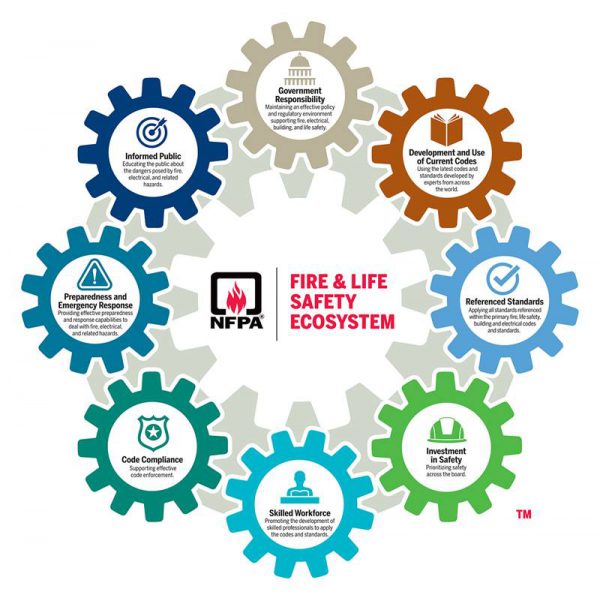 Image: NFPA Website The fire and life safety ecosystem led the discussion at the 2018 NFPA Conference and Expo. What is the fire and life safety ecosystem? Like any ecosystem, it is comprised of elements that work together to achieve a functioning system—in this case, eight separate elements that have to do with fire and safety. Several of them are the responsibility of the government, while many call upon the public to enforce and deliver. Regardless of who is charged with the responsibility, the goal throughout the ecosystem is to prevent major disasters from fire, electrical, and other hazards. When tragedies occur, it is likely there was a breakdown in one or more parts of the fire and life safety ecosystem. Here are the eight components relating to the fire and life safety code:
- Government Responsibility: Policy makers must maintain effective policy and regulatory environment and not prioritize politics over the public’s safety. When life safety codes are stripped for any reason, people’s lives are endangered for the sake of political gain.
- Development and Use of Current Codes: Government and building designers must implement the latest codes and standards or risk losing the latest technology and research in fire, electrical, life safety.
- Referenced Standards: All standards within the fire, life, building, safety, and electrical codes must be addressed or the right products and practices will not be used, possibly leading to disastrous results.
- Investment in Safety: Property managers and need to make an investment in safety to comply with the latest standards and codes. Hiring a company like Total Fire and Safety means an investment in safety. All the latest fire safety technologies are always available from TFS and we can design a program to fit any company’s needs and budget.
- Skilled Workforce: Promote the development of skilled professionals to apply the codes and standards. For over 20 years, TFS has employed highly skilled, highly trained, and highly dedicated workers in order to put customers’ safety above all else.
- Code Compliance: Effective code enforcement is necessary. Fire Marshalls and other officers must conduct regular inspections to ensure safety and code compliance.
- Preparedness and Emergency Response: Provide effective preparedness and emergency response capabilities to deal with fire, electrical, and related hazards. Train employees on emergency equipment, fire safety drills, designated leader in emergencies, etc.. TFS provides training classes for employees, as well as, informative literature on how to react in an emergency and much more.
- Informed Public: Educating the public is important, as is educating businesses about the specific fire hazards in their facilities.
No one cog in the fire and life safety ecosystem can keep us all safe from harm. Even all the pieces together, working in tandem, may not prevent every disaster, but they can certainly prevent many. By practicing and implementing the various areas outlined in the fire and life safety ecosystem, we can all create a safer community. At Total Fire and Safety, we are committed to helping you play your role in the fire and life safety ecosystem. Contact us today to discuss your fire safety needs or call 630-960-5060.
Category: Business Safety, Fire code violation, Fire Safety, Health and Safety, NFPA Compliance, Total Fire and Safety Tags: fire and safety equipment, fire and safety needs, fire and safety solutions, fire safety solution, fire safety training, Total Fire and Safety | Comments Off on What’s a Fire and Life Safety Ecosystem?
-
December 4, 2018 by Total Fire and Safety

A brand new year is a great time for businesses to evaluate what they can improve upon, even in terms of their commercial fire safety. No business is completely immune to accidental fires and having the right equipment in place year round can prevent potential devastation.
According to the National Fire Protection Association (NFPA), more than 3,300 fires break out in office buildings across the U.S each year. The NFPA reports that a number of people are killed or injured with an estimated $112 million in property damage.
If you’re a business set on achieving your 2019 goal of reaching NFPA compliance, take a look at checklist of equipment you need below for commercial fire safety. Anything missing? Call Total Fire & Safety. We can help!
____ Alarms
____ Extinguishers and Suppression Systems
- Conduct tests regularly to ensure function and pressure when activated.
- Schedule routine maintenance of equipment.
- Store extinguishers in open areas for easy access.
____ Emergency Lighting
- Effective emergency lighting throughout the building will help occupants to safety in an emergency.
- Schedule regular maintenance and inspections.
Equipment is essential and necessary to prevent major damage but people are too! Whether it’s putting out a fire or tending to the injured, what good is the equipment if you don’t have employees able to use it?
____ First Aid
____ Training Courses
- A comprehensive fire equipment training course on the use of fire equipment and first aid can place confidence in employees and keep everyone safe.
- Training employees reduces the chance of small fires starting and spreading.
You could have all the equipment ready and employees trained to use it but they need something else.
____ Emergency Preparedness Plan
- Remind employees to REACT-(remove from danger, ensure doors/windows are closed, activate alarm, call 911, treat as dangerous.)
- Conduct fire drills.
- Schedule inspections of all fire equipment.
- Have employees trained on firefighting equipment.
Making sure you have commercial fire safety in place can seem a daunting task but the pros at Total Fire and Safety are here to simplify it. TFS covers everything including inspection, maintenance, training, and keeping your building up to code so you are well protected in the event of an unforeseen fire. Give us a call today at 630-960-5060.
Category: Business Safety, Fire Alarm Monitoring, Fire Equipment Inspections, Fire exits, Fire Extinguishers Tags: commercial fire protection, commercial fire safety, commercial first aid kit, emergency exit lights, emergency lighting, fire and safety solutions, Fire Extinguisher, fire safety, fire safety training, fireextinguisher, firesafetytraining, firesprinklerinspections, first aid | Comments Off on The Business Owner’s Checklist for Commercial Fire Safety in 2019
-
March 15, 2018 by Total Fire and Safety
 Nobody thinks much about emergency exit lights. But if the power suddenly goes out, smoke fills the room and you can’t see a foot in front of you, relying on the emergency lights may be your only means of escape. Nobody thinks much about emergency exit lights. But if the power suddenly goes out, smoke fills the room and you can’t see a foot in front of you, relying on the emergency lights may be your only means of escape.
Emergency exit lights are essential to safety in any dangerous situation. They can alarm someone in a fire, be the only source of light in the dark, and the key to safely exiting the building. Emergency exit lights are often overlooked and taken for granted, but take note of how many you come across every day. Do you realize how many requirements and regulations go into the installation and maintenance of one exit sign?
There are numerous agencies that govern emergency exit lighting and signs: OSHA (Occupational Safety and Health Administration), NFPA (National Fire Protection Administration, JCAHO (Joint Commission on Accreditation of Healthcare Organizations and the International Building Code and International Fire Code. Above all these agencies, the local authority is responsible for monitoring and enforcing building/fire codes.
According to OSHA, an exit route is defined as a continuous and unobstructed path of exit travel from any point within a workplace to a place of safety. There are three parts to an exit route:
- Exit access-part of the exit route that leads to an exit.
- Exit-part of the exit route that is separated from other areas and provides a safe means of travel to exit discharge.
- Exit discharge-part of the exit route that leads to directly outside or refuge area.
OSHA’s requirements for the lighting of these afore mentioned exit routes is covered under 1910.37(b). It states that each exit route must be sufficiently lighted so an employee with normal vision can see along the exit route and each exit must be clearly visible and marked by a sign reading “EXIT.” Additional information for OSHA requirements can be found at www.osha.gov.
The NFPA guidance for emergency exit lighting and signs can be found in the NFPA 101, Life Safety Code. The NFPA’s Life Safety Code provides information for placement, illumination, and visibility for exit signs.
- Placement of exit sign. Any exit signs must be located so that no point in an exit access area is more than the sign’s viewing distance, or 100 feet from the nearest sign.
- Visibility of exit signs-Every sign must be located and of such size, distinctive color and design that is visible and contrasts from the background of its placement. NFPA also states no decorations, furnishings, or equipment that impairs visibility of a sign shall be permitted. Nothing should be placed near an exit sign that distracts attention and inhibits visibility of an exit sign.
- Illumination of Exit Signs-The NFPA states all exit signs must be illuminated by a reliable light source and legible in normal and emergency exit lighting modes. There are two categories of illumination: external illumination, which comes from outside the exit sign and internal illumination, which comes from a source inside an exit sign.
According to the NFPA, emergency illumination must be provided for a minimum of 1.5 hours in the event of power outage. The emergency lighting must be illuminated not less than an average of one lumen per square foot. The maximum illumination at any point can be 40 times the minimum illumination. All emergency exit lighting must be able to provide lighting automatically when normal light is interrupted.
Many emergency exit lights are now using LED lights. The NFPA states that LED lights are longer lasting, provide better light and are most durable. In emergency situations, LED lights emit sufficient lighting and are most effective when placed properly. They are also most energy efficient, saving the building money.
According to the NFPA requirements for testing, there are three categories of emergency lights: traditional, self-testing, and computer base self-testing. A monthly activation test which involves having the lights illuminate for no less than 30 seconds and an annual test which keeps the lights illuminated for 1.5 hours, simulating a long-term emergency. Records of these test must be maintained for inspection.
Many regulations, codes, and considerations go into the signs and lights you see every day so it is important to have regular maintenance and testing of these lights. Total Fire and Safety has a knowledge team for inspecting emergency exit lighting. With regular maintenance and testing from Total Fire and Safety, you can be assured your emergency exit lighting is up to code and the safety of your employees/tenants is assured. Give us a call today 630-960-5060.
Category: Business Safety, Fire code violation, Fire Equipment Inspections, Fire exits, Fire News, Fire Safety, Health and Safety, LED Lighting, NFPA Compliance, Total Experience, Total Fire and Safety Tags: commercial fire protection, commercial fire safety, emergency exit lights, emergency lighting, fire and safety equipment, fire and safety needs, fire and safety solutions, fire safety in the news, fire safety solution, fire safety training, lifesafety, safety | Comments Off on Are You In the Dark About Emergency Exit Lights?
-
February 14, 2017 by Total Fire and Safety

If you visit the TFS headquarters in Woodridge, Illinois, make sure you take a look at our newly remodeled training room. Training is essential to what we do at Total Fire & Safety, not only for new employees but to help existing ones stay up-to-date on the latest hazards, fire codes and prevention techniques.
Our existing employees know the training room well. This is a picture of our fire extinguisher division meeting. Every month, each division of Total Fire & Safety, fire extinguisher, sprinkler, fire alarm and backflow, meet for monthly training and information exchange sessions. By gathering together, our team in each division can share information about their experiences in the field and discuss what is working or needs to be improved. Each division has their own concern with fire safety, so holding these division exclusive meetings is very helpful.
Who benefits most from these meetings? The TFS customer!
These meetings are one of many ways TFS is always trying to become more efficient and stay abreast of the latest in fire prevention and NFPA codes for their customers. The meetings help Total Fire & Safety deliver their very best in expertise, installation, maintenance and customer service to all our wonderful customers.
Thank you to all of our customers for making 2016 a great year for us. We promise to do everything we can as your commercial fire protection company to make 2017 a safe one for your commercial fire safety. If you have any questions about fire safety for your business or want to update your fire equipment going into the new year, don’t hesitate to contact us at 630-960-5060.
Category: Fire Safety, Total Fire and Safety Tags: fire professional training, fire safety training, fire training, Total Fire and Safety, total fire training | Comments Off on A New Year in TFS’s Commercial Fire Protection Training Room
-
August 17, 2016 by Total Fire and Safety
If you are an employer with ten or more employees, you are probably aware that OSHA requires you to conduct fire safety training and first aid training for your employees. But what is the value of this safety training? Does it really make a difference, or is it just a technicality?
The fact is, different ki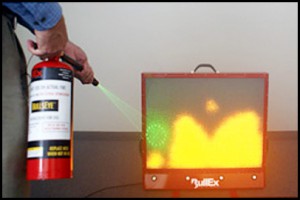 nds of occupational injuries and accidents, including fire safety ones, cost companies thousands and even millions of dollars a year. These include the direct costs of property damage and employee injury as well as the indirect costs of production down time and the intangible profitability loss from the lingering emotional effect on the morale of the employees. If you’ve ever wondered what that dollar amount would be for an injury at your jobsite, OSHA developed a calculator tool that you can use to see the cost of an injury at your business. As an employer, you are liable for the injuries or accidents that happen in your workplace, so making sure your employees are properly trained can save you money. nds of occupational injuries and accidents, including fire safety ones, cost companies thousands and even millions of dollars a year. These include the direct costs of property damage and employee injury as well as the indirect costs of production down time and the intangible profitability loss from the lingering emotional effect on the morale of the employees. If you’ve ever wondered what that dollar amount would be for an injury at your jobsite, OSHA developed a calculator tool that you can use to see the cost of an injury at your business. As an employer, you are liable for the injuries or accidents that happen in your workplace, so making sure your employees are properly trained can save you money.
The American Society of Safety Engineers (ASSE) has gathered extensive data on the effectiveness of quality safety training programs, and the results are promising. Some of their findings include:
- OSHA estimates that companies that implement effective safety programs can expect reductions of 20% or greater in injury and illness rates, as well as a return of $4 to $6 for every $1 invested in the programs.
- Workplace injuries will cost society $128 billion in losses this year, which equals one-quarter of each dollar of pre-tax corporate profits
- Indirect costs of injuries may be 20 times the direct costs — Indirect costs include: training and compensating replacement workers; repairing damaged property; accident investigation and implementation of corrective action; scheduling delays and lost productivity; administrative expense; low employee morale and increased absenteeism; poor customer and community relations
- Conducting effective safety training has been proven to lower your Workplace Modification Factor, which insurance companies use to assess businesses and determine their rates.
All in all, studies have proven that safety training programs can save your business money and grief. More ASSE reports on the returns on safety training investment can be found here.
The best safety training programs will be tailored to the type of injuries or accidents your employees are most likely to encounter. This is especially true in the realm of fire safety training, where different companies will need to know different things about the fires they are most likely at risk for in their working environment. As a result, all fire safety and first aid training programs are not alike. Choose the best fire safety training program or first aid training program for your company.
For more information on the specific needs of your business and how to achieve OSHA standards at a practical price, contact your local OSHA consultation office. Offering the right fire safety training and first aid training courses that prevent injuries will empower your employees to handle emergency situations well and prevent potentially fatal injuries. Don’t fail them! Look into Total Fire & Safety training today! For more information, contact Total Fire & Safety at 630-960-5060.
Category: Fire Extinguishers, Fire Safety Tags: Fire Extinguisher, fire extinguisher programs, fire extinguisher safety training programs, fire extinguisher training, fire safety training, first aid training, good fire training programs, OSHA fire training, safety training programs | Comments Off on How Fire Safety Training Pays
-
April 13, 2016 by Total Fire and Safety
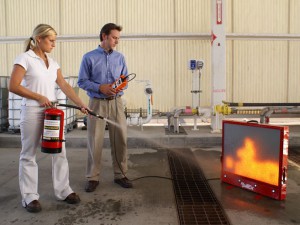
If your business has more than ten employees, they are going to need annual fire safety training. Some businesses rush to the least expensive program that will satisfy OSHA requirements, assuming that all training is the same; however, that’s simply not true. Fire safety training can vary in quality based on a number of factors, and many come with “hidden” fees that you may not be aware of. So what should you look for? Here are some important questions to ask before you book the training company.
1. What kind of course would you recommend? The course you need for your company should address the most probable emergencies that can occur at your facility. A training company worth its salt will tailor the course to your needs, surveying your business ahead of time to determine the most important content needed for your employees.
2. Who is teaching the course? Make sure the instructors are experienced professionals who know what real emergencies are like and how they occur. It’s even better if the instructor has experience with real-life emergencies. Nothing compares to the knowledge of a first responder who has faced countless fires and hazardous events. They can share personal stories, anecdotes and examples related to the training, which can make the class more interesting.
3. What will the course cover? Basic training courses cover how to use the fire extinguisher, but the most important thing employees should learn is WHEN to use the fire extinguisher. A good training course will focus on the importance of making fast and accurate, life-or-death decisions. Not only should your employees know how to fight fires, but also WHEN to fight the fire, and most importantly, when not to fight the fire. Evacuating and leaving it to the professionals is sometimes the best decision an employee can make.
4. Where will the training take place? Many fire safety trainings are performed outdoors, with a live burn in a pan that employees practice extinguishing. Although exciting, putting out a pan fire in a parking lot does not accurately simulate a realistic fire or emergency situation! Also, elements of the weather such as wind can affect the fire and unrealistically hamper the efforts of the employee trying to learn proper extinguishing techniques. It is much more effective to practice emergency procedures where they actually occur—inside the facility. With the help of digital technology, your employees can learn to extinguish the exact type of fire they would most likely face right at their worksite. This “on-the-spot” training also helps employees develop realistic evacuation plans and teach them to work as a team in an emergency situation.
5. Will there be extra costs involved with the equipment or the course materials? If the trainer is using “live burns”, or actual fires to practice extinguishing, you will need to have a burn permit and may incur any associated costs with setting up an outdoor space needed for the demonstration. If the training company uses your fire equipment for a live burn session, you will have to recharge them. You may not have budgeted for this unexpected, volatile cost, and it will vary based on how many turns each participant receives to extinguish the fire. The fire safety courses offered by Total Fire & Safety use high-tech, virtual simulators to practice extinguishing fires, which are versatile and allow more practice for each participant. These simulators feature virtual fire on a screen that responds realistically to the participant’s motions with the fire extinguisher. The indoor training gives each person multiple attempts with a full extinguisher every time until they feel confident with their firefighting skill. Compared to outdoor training, simulated training is more cost effective, accurate, completely green, and requires no messy clean-up or permit fees.
So before booking a company to perform fire safety training for your employees, ask these questions to make sure you receive your money’s worth for your employees and your business. No one can predict how an emergency will unfold, but the right training company can make sure your employees are not only prepared to fight a fire, but are adept at making quick decisions about whether or not it is safe to do so. For more information, contact the professionals at Total Fire & Safety at 630-960-5060.
Category: Fire Extinguishers, Fire Extinguishers, Fire Safety, Total Fire and Safety Tags: employee training, Fire Extinguisher, fire safety, fire safety training, fire training, fire training technology | Comments Off on Five Important Questions to Get Your Money’s Worth from Fire Safety Training
-
February 26, 2016 by Total Fire and Safety
 You may think you know the importance of first aid and fire safety, but the real impact of first aid and fire equipment training in the workplace is often overlooked. Whether your business is a high or low-risk environment, there are always risks that can lead to medical emergencies. You may think you know the importance of first aid and fire safety, but the real impact of first aid and fire equipment training in the workplace is often overlooked. Whether your business is a high or low-risk environment, there are always risks that can lead to medical emergencies.
1. Increasing profitability. A safer workplace means less missed workdays due to injuries. According to the National Safety Council, in 2012, nearly 5 million workers were injured at work, which costed employers a total of $198.2 billion.
2. Saving your employees time and money. It is proven that businesses and employees will save money if accidents are handled quickly and effectively. The National Safety Council attests that 25 percent of all emergency room visits can be avoided with basic first aid and CPR certification.
3. It really does save lives. If your employees don’t know how to handle injuries, the condition of the victim could worsen before the ambulance arrives, and cause further trauma and debilitation, not to mention medical costs and possibly, even death. Having a commercial first aid kit on the job sends a message to your employees that you value their health and well-being and are doing all you can to mitigate any injuries that occur on the job. It also shows that you never want your employees to be vulnerable to unattended injury.
4. It is required by law for many workplaces. The Occupational Safety and Health Administration requires businesses to provide first aid and CPR training to employees if there is no nearby clinic or hospital. Make sure you also have a commercial first aid kit available in your workplace. Obviously, if your business deals with risky materials or conditions, having a commercial first aid kit makes sense whether or not you are bound by law.
5. Teach your employees how to use emergency equipment. You spend money keeping your workplace up to code with commercial fire extinguishers and first aid kits, but these things don’t handle emergencies by themselves! Your employees need to know how to work fire extinguishers and use first aid supplies correctly. The investment need not be costly; a simple on-site class with the staff in attendance should suffice.
Total Fire & Safety can handle all your needs whether it be fire extinguishers, first aid kits, fire extinguisher training, or first aid training. For more information, visit our website or you can contact us at 630-960-5060.
Category: Fire Extinguishers, Fire Safety, First Aid Kits, Total Fire and Safety Tags: fire safety training, fire training, first aid, first aid kit, first aid training, training | Comments Off on Five Reasons Why Employees Should Have First Aid Training
|

|
|
|
|
|
|



 Facebook
Facebook
 Instagram
Instagram
 LinkedIn
LinkedIn




 Nobody thinks much about
Nobody thinks much about 



